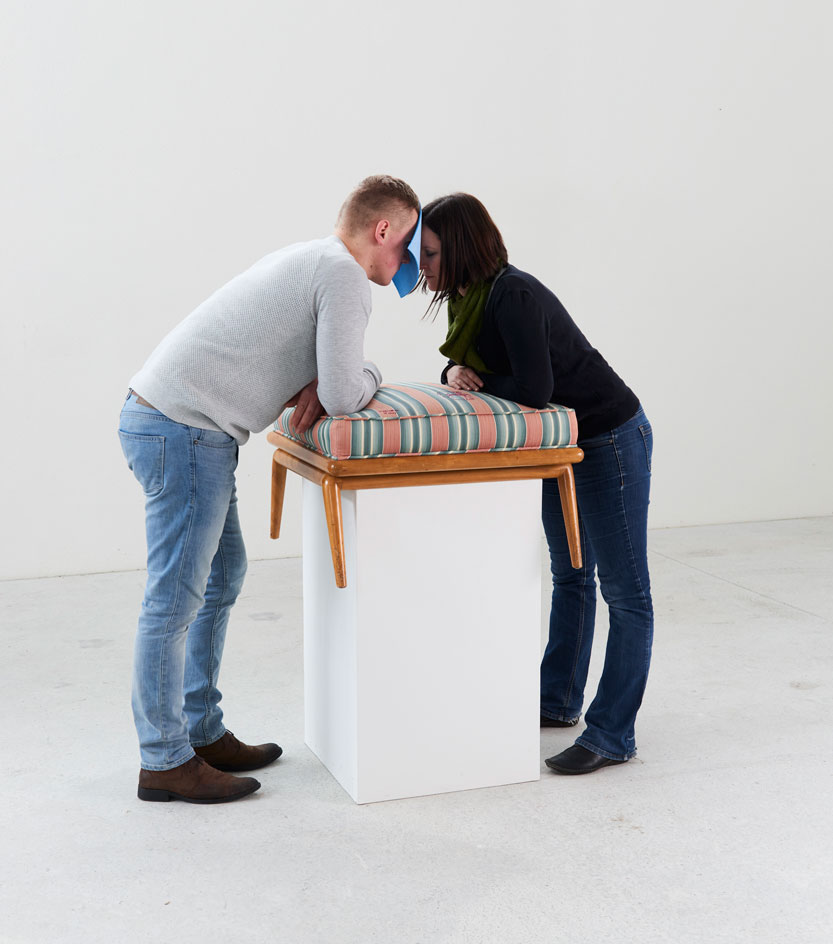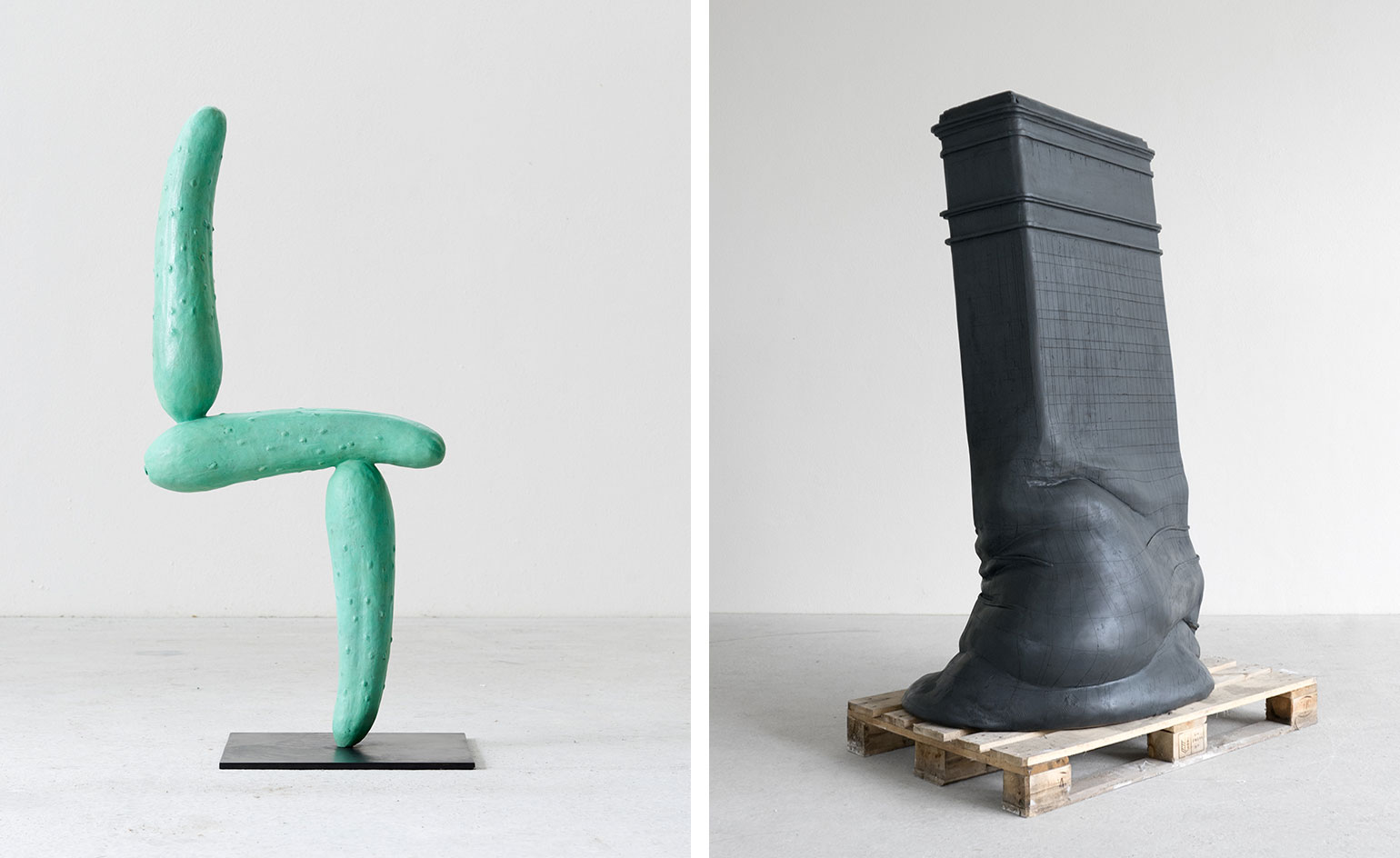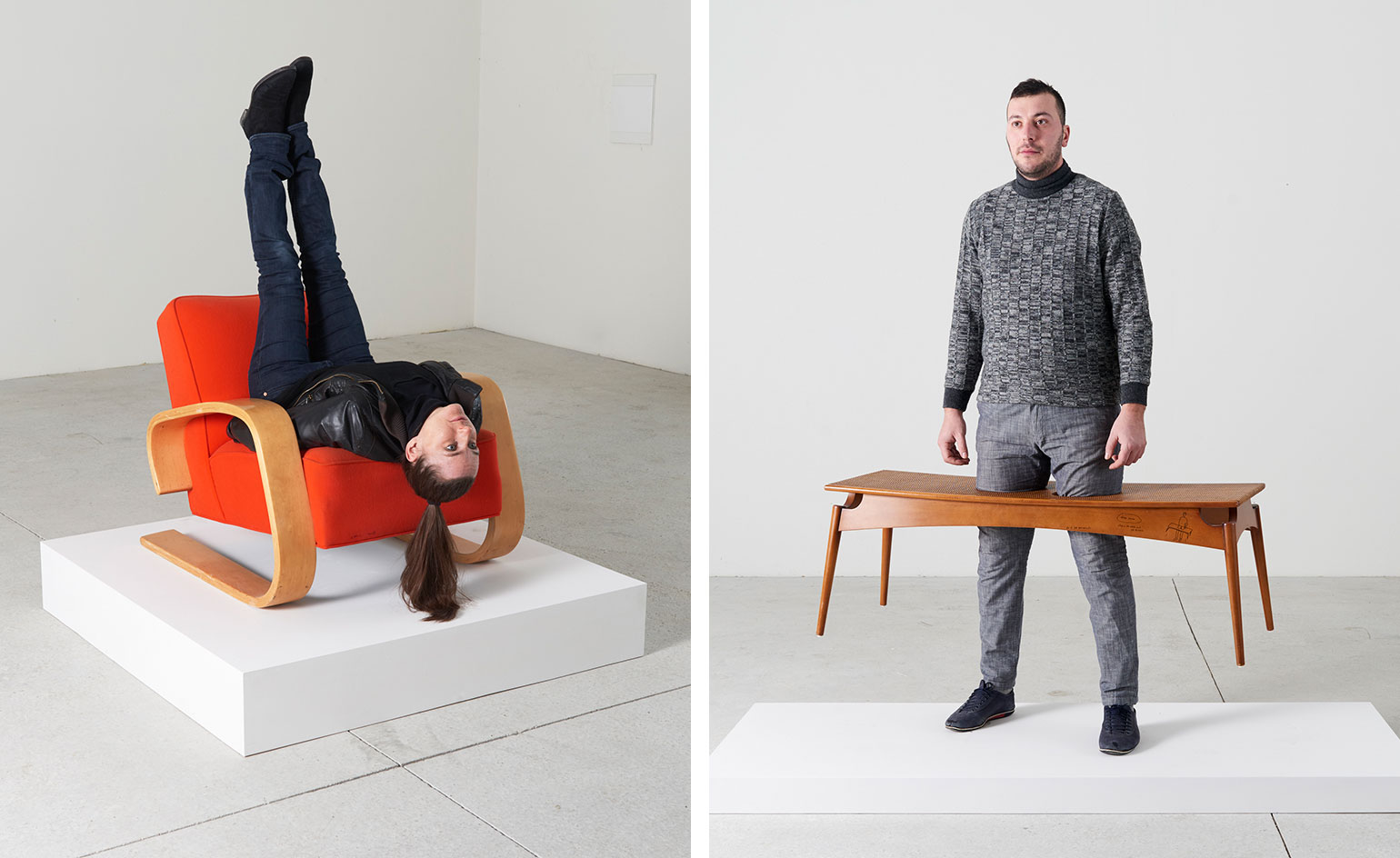Do you have a minute? Erwin Wurm debuts a new series of short-lived sculptures

In conjunction with the Austrian artist Erwin Wurm’s 20th anniversary of his one-minute sculptures - for which he is best known - New York’s Lehmann Maupin gallery is showing ’Ethics demonstrated in geometrical order’, displaying Wurm’s newest one-minute series and five new sculptures.
’The one-minute sculptures have changed a lot over the years since the first show I did in 1997,’ says Wurm. ’At first I tried playing around with the idea of sculptures who had a short existence, then it was me interacting with them, and later I thought it would be interesting to involve the public.’ The one-minute sculptures will also be presented at this year’s Venice Biennale.
The basic premise stays consistent. For each work, Wurm presents an object and creates a drawing and specific text inscribed on that object to instruct the user how to pose with it for one minute. The resulting awkward contortions are humorous, but the interaction contains deeper meanings. ’It’s related to issues of science, philosophy, psychology and explores ideas of free will and authorship,’ Wurm says. ’For a while, I used to make the drawing inviting the pubic to follow my instructions, then I would take a Polaroid photo and would offer to sign it for them, so it became an interplay of who was the author of the finished result. Then the iPhone came along and selfies happened and people were making one-minute sculptures on their own.’

'Organisation of Love', 2016, by Erwin Wurm as part of One Minute Sculptures
For this show, Wurm selected midcentury modern furnishings due to their current popularity. ’Furniture is something I’ve always found particularly intriguing because at the beginning everyone thinks something is unique, but then it becomes part of mass taste. People try to illustrate themselves and their lives through their furnishings,’ he explains. Throughout his work, Wurm plays with our common perception of how everyday items should be experienced, from household objects and furniture, to cars and buildings.
Wurm also presents partially melted sculptures of two New York landmarks, the Equitable building and the Flat Iron building in addition to seemingly random objects like a bag of clay and pickles. All of the sculptures distort the item, either by giving it an inflated, fat look, or as Wurm describes the melting process, ’double-destoys it.’ By changing the forms in these ways, Wurm believes he also changes the larger context and meaning of the object itself, even if that new meaning is unique to each viewer.

Left, Salatgurke Modernistisch, 2016. Right, Flat Iron, 2016

Left, Spaceship to Venus, 2016. Right, Deep Snow, 2016
INFORMATION
’Ethics demonstrated in geometrical order’ will be on view through 26 May. For more information, visit Lehmann Maupin’s website
Receive our daily digest of inspiration, escapism and design stories from around the world direct to your inbox.
ADDRESS
536 West 22nd Street
New York, NY, 10011
Pei-Ru Keh is a former US Editor at Wallpaper*. Born and raised in Singapore, she has been a New Yorker since 2013. Pei-Ru held various titles at Wallpaper* between 2007 and 2023. She reports on design, tech, art, architecture, fashion, beauty and lifestyle happenings in the United States, both in print and digitally. Pei-Ru took a key role in championing diversity and representation within Wallpaper's content pillars, actively seeking out stories that reflect a wide range of perspectives. She lives in Brooklyn with her husband and two children, and is currently learning how to drive.
-
 ‘I want to bring anxiety to the surface': Shannon Cartier Lucy on her unsettling works
‘I want to bring anxiety to the surface': Shannon Cartier Lucy on her unsettling worksIn an exhibition at Soft Opening, London, Shannon Cartier Lucy revisits childhood memories
-
 What one writer learnt in 2025 through exploring the ‘intimate, familiar’ wardrobes of ten friends
What one writer learnt in 2025 through exploring the ‘intimate, familiar’ wardrobes of ten friendsInspired by artist Sophie Calle, Colleen Kelsey’s ‘Wearing It Out’ sees the writer ask ten friends to tell the stories behind their most precious garments – from a wedding dress ordered on a whim to a pair of Prada Mary Janes
-
 Year in review: 2025’s top ten cars chosen by transport editor Jonathan Bell
Year in review: 2025’s top ten cars chosen by transport editor Jonathan BellWhat were our chosen conveyances in 2025? These ten cars impressed, either through their look and feel, style, sophistication or all-round practicality
-
 Out of office: The Wallpaper* editors’ picks of the week
Out of office: The Wallpaper* editors’ picks of the week'Tis the season for eating and drinking, and the Wallpaper* team embraced it wholeheartedly this week. Elsewhere: the best spot in Milan for clothing repairs and outdoor swimming in December
-
 Out of office: The Wallpaper* editors’ picks of the week
Out of office: The Wallpaper* editors’ picks of the weekFar from slowing down for the festive season, the Wallpaper* team is in full swing, hopping from events to openings this week. Sometimes work can feel like play – and we also had time for some festive cocktails and cinematic releases
-
 The Barbican is undergoing a huge revamp. Here’s what we know
The Barbican is undergoing a huge revamp. Here’s what we knowThe Barbican Centre is set to close in June 2028 for a year as part of a huge restoration plan to future-proof the brutalist Grade II-listed site
-
 Out of office: The Wallpaper* editors’ picks of the week
Out of office: The Wallpaper* editors’ picks of the weekIt’s wet, windy and wintry and, this week, the Wallpaper* team craved moments of escape. We found it in memories of the Mediterranean, flavours of Mexico, and immersions in the worlds of music and art
-
 Each mundane object tells a story at Pace’s tribute to the everyday
Each mundane object tells a story at Pace’s tribute to the everydayIn a group exhibition, ‘Monument to the Unimportant’, artists give the seemingly insignificant – from discarded clothes to weeds in cracks – a longer look
-
 Out of office: The Wallpaper* editors’ picks of the week
Out of office: The Wallpaper* editors’ picks of the weekThis week, the Wallpaper* team had its finger on the pulse of architecture, interiors and fashion – while also scooping the latest on the Radiohead reunion and London’s buzziest pizza
-
 Out of office: The Wallpaper* editors’ picks of the week
Out of office: The Wallpaper* editors’ picks of the weekIt’s been a week of escapism: daydreams of Ghana sparked by lively local projects, glimpses of Tokyo on nostalgic film rolls, and a charming foray into the heart of Christmas as the festive season kicks off in earnest
-
 Wes Anderson at the Design Museum celebrates an obsessive attention to detail
Wes Anderson at the Design Museum celebrates an obsessive attention to detail‘Wes Anderson: The Archives’ pays tribute to the American film director’s career – expect props and puppets aplenty in this comprehensive London retrospective